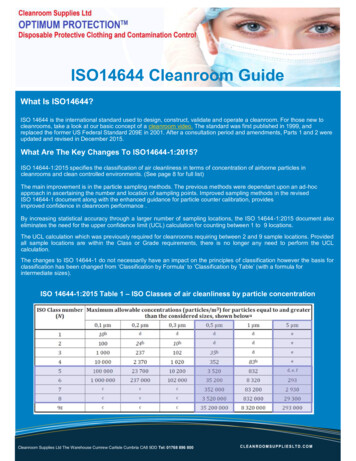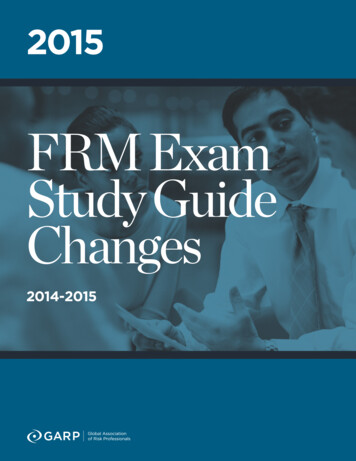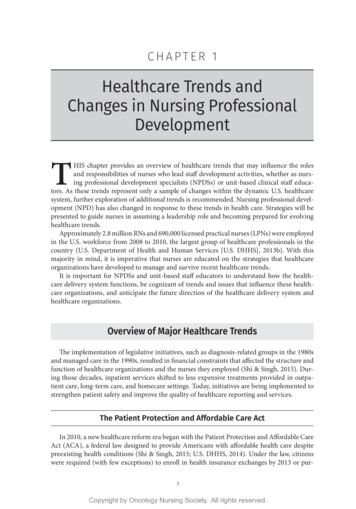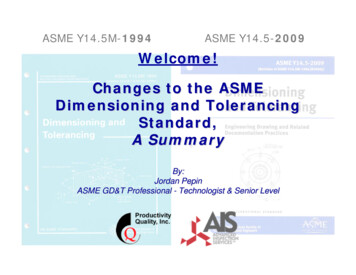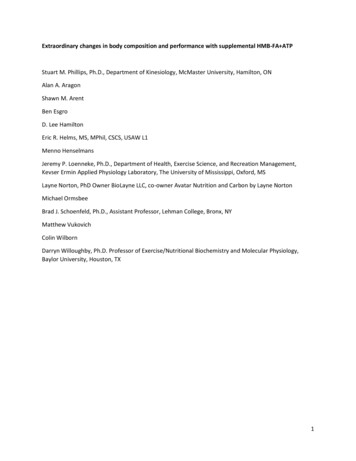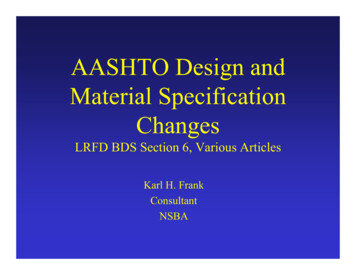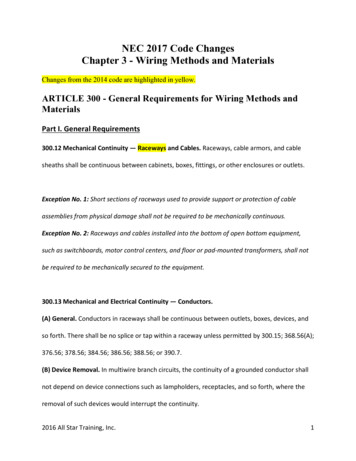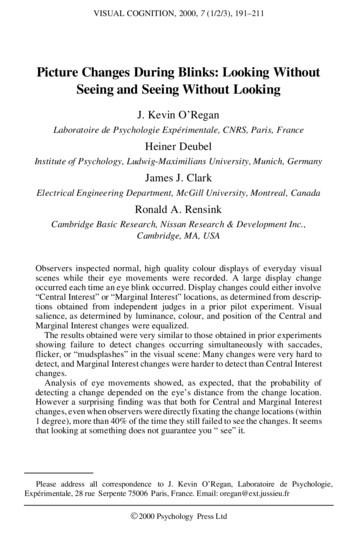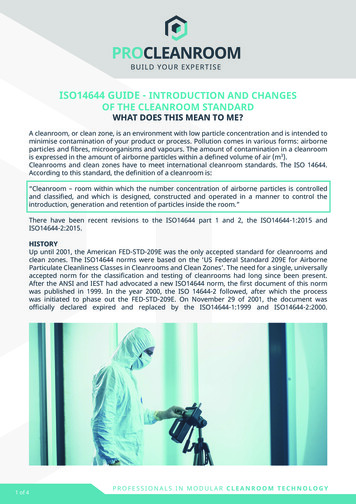
Transcription
ISO14644 GUIDE - INTRODUCTION AND CHANGESOF THE CLEANROOM STANDARDWHAT DOES THIS MEAN TO ME?A cleanroom, or clean zone, is an environment with low particle concentration and is intended tominimise contamination of your product or process. Pollution comes in various forms: airborneparticles and fibres, microorganisms and vapours. The amount of contamination in a cleanroomis expressed in the amount of airborne particles within a defined volume of air (m3).Cleanrooms and clean zones have to meet international cleanroom standards. The ISO 14644.According to this standard, the definition of a cleanroom is:“Cleanroom – room within which the number concentration of airborne particles is controlledand classified, and which is designed, constructed and operated in a manner to control theintroduction, generation and retention of particles inside the room.”There have been recent revisions to the ISO14644 part 1 and 2, the ISO14644-1:2015 andISO14644-2:2015.HISTORYUp until 2001, the American FED-STD-209E was the only accepted standard for cleanrooms andclean zones. The ISO14644 norms were based on the ‘US Federal Standard 209E for AirborneParticulate Cleanliness Classes in Cleanrooms and Clean Zones’. The need for a single, universallyaccepted norm for the classification and testing of cleanrooms had long since been present.After the ANSI and IEST had advocated a new ISO14644 norm, the first document of this normwas published in 1999. In the year 2000, the ISO 14644-2 followed, after which the processwas initiated to phase out the FED-STD-209E. On November 29 of 2001, the document wasofficially declared expired and replaced by the ISO14644-1:1999 and ISO14644-2:2000.1 of 4
procleanroom.comOver the past 5 years, the technical committee has been working on a revision of the basedocuments 14644-1 and -2. The update was set up specifically to improve the cleanroomstandard, with the following points of departure: Simplify the classification process and if possible remove the ‘95% upper confidence limit’(UCL) for a low number of sample locations.Review the classification procedure and focus more on cleanrooms in practice.Generally adjust the standard to current ways of thinking and sector requirements.Prevent large adjustments to the principles of the current ISO classes 1-9.Simplify and clarify the requirements and guidelines related to testing frequency andmonitoring clean zones and cleanrooms.See how testing intervals can be extended, if automatic monitoring systems are in place toshow it is under control.After feedback from users and experts, the newest revisions of 14644-1 and -2 were accepted bythe majority of the ISO committee. Since 2016, the new revisions are increasingly being adoptedby the industry.DEFINITIONSISO14644-1:2015 – Cleanrooms and associated controlledenvironmentsPart 1. ‘Classification of air cleanliness by particle concentration’This part, with an altered title compared to the ISO146441:1999, specifies the cleanliness classes for cleanroomsand monitored environments worldwide, based on thenumber of particles as concentration in air volume. Italso specifies the standard testing methods to determineclasses, including the selection of sample locations andthe use of ‘light scattering airborne particle counters’.It is the first chapter in a series of documents that describethe testing methods and limits. The standard is used invarious market sectors, including micro-electronics,pharmaceuticals, aerospace industry, medical devices,healthcare and the food industry.ISO14644-2:2015 – Cleanrooms and associated controlled environmentsPart 2. ‘Monitoring to provide evidence of cleanroom performance related to air cleanliness by particleconcentration’Describes the specifications for a monitoring plan based on a risk analysis focussing on plannedusage. This part has also had a change in title compared to the old ISO14644-2:1999.Collected data offers proof for performance of the cleanrooms or clean zone performance,related to air cleanliness based on the number of particles as concentration in air volume.For the complete overview of all parts of the ISO14644, see Annex 1, table 1.MOST IMPORTANT CHANGES IN ISO14644-1:2015The most important change is in the field of sampling methods. Previous methods were to acertain extent dependent on personal interpretations in order to determine the number ofsamples and especially sample locations. The improved sampling method in the updatedISO14644-1:2015 combined with an improved guideline regarding the calibration ofparticle counters increases confidence in the performance of tested cleanrooms.2 of 4
procleanroom.comThe statistical accuracy has been increased by increasing the number of sample locations andthe evaluation of collected data. This has eliminated the need for the ‘95% Upper ConfidenceLimit’ (UCL). The UCL calculation was previously necessary for cleanrooms with 2 to 9 samplelocations. The number of sample locations is now determined by a table (see Annex 2, table 1)instead of a formula.The cleanroom or clean zone should also henceforth be divided into a grid with a numberof sections equal to the required number of locations in table 1 (Annex 2). The samplelocations are to be located within the individual sections. The layout of the cleanroomor clean zone, the presence of machinery and air flow systems is to be consideredwhen determining sample locations. Additional sample locations may be added tothe required minimum number.The limits for particles with a size of 5.0 micron have been taken out for ISO class 5, in theguiding table (see table 1) for limits on particle size specified per ISO class. The reason for thisis the statistical and sample limitations for particles in low concentrations. This can makemeasurements unreliable. For the complete overview with a cross table to the FED 209Eand the EU GMP, see table 2 and 3 in Annex 1.Table 1: Maximum concentration limits (particles/m3 of air)ISO Classification number 0,1 μm 0,2 μm 0,3 μm 0,5 μm 1,0 μm 5,0 μmISO Class 1102----ISO Class 210024104--ISO Class 31.000237102358-ISO Class 410.0002.3701.02035283-ISO Class 5100.00023.70010.2003.52083229ISO Class 61.000.000237.000102.00035.2008.320293ISO Class 7---352.00083.2002.930ISO Class 8---3.520.000832.00029.300ISO Class 9---35.200.0008.320.000293.000Source: NEN-EN-ISO 14644-1Note: The current EU GMP norms still require measurements for particles of 5.0 micron in sizein Grade A and B environments for both classifications and reclassifications and monitoring. Inorder to determine 5.0 micron particle size for ISO class 5, the ‘M descriptor’ may be used.The ISO14644-1:2015 describes the considerations for classifications related to particle sizes of0.1 to 5 microns diameter. Smaller particles (nanoparticales) are now separately describedin part 12 (14644-12).Decimal classes are no longer determined by a formula in the ISO14644-1:2015. The formulahas been taken out and replaced by a table (see Annex 3, table 1).MOST IMPORTANT CHANGES IN ISO14644-2:2015The ‘At rest’ and ‘In Operation’ classification is to be regularly executed with the purpose ofa risk analysis and a resulting monitoring strategy/plan of the cleanroom or clean zone,focussed on the specific process of the user. If the cleanroom or clean zone is equipped withmachinery for continuous monitoring for contamination by airborne particles (as aresult of the risk analysis), the validation interval of the classification can be longer, if desired.Naturally, this is only the case if the results of continuous monitoring remain withinspecifications. In the pharmaceutical and related industries, the interval should be nolonger than a year.3 of 4
procleanroom.comParticle countersThe requirements for particle counters have been described in the ISO14644-3 sinceits publication in 2005 and is in line with the ISO21501-4.ISO21501-4 ‘Determination of particle size distribution - Single particle light interactionmethods – Part 4: light scattering airborne particle counter for clean spaces’In order to increase confidence in the performance of tested cleanrooms and cleanzones, the revised ISO14644-1 contains criteria for particle counters as specified in ISO14644-3. It offers consistent testing methods for the calibration of particle counters.Although many particle counters on the market have been designed for use in spaceswith low particle concentrations, certain devices provide inaccurate results. This meanssome devices will not meet the requirements set by the ISO21501-4 and ISO14644-4.Calibration of particle counters should now meet the requirements set by ISO21501-4.SUMMARISING THE MOST IMPORTANT CHANGESThe non-extreme changes influence all users of cleanrooms and clean zones to agreater or lesser extent. Substantial changes have been implemented which influence theway cleanrooms and clean zones are classified, as well as particle counter requirements. The number of sample locations is no longer determined by a formula (total room m2), butis now directly dictated by a table (see Annex 2, table 1).Sample locations are to be spaced out in a grid.Particles of 5 micron in ISO class 5 environments have been removed from the table forconcentration limits.The UCL calculation is no longer necessary (class 2 through 9). Each sample is consideredindividually and is to meet the limit for the class in question.Particle counters are to be calibrated and verified according to ISO21501-4 (following fromISO14644-3).Classification interval should follow from a risk analysis and a resulting monitoring plan.Applying continuous monitoring systems can offer a longer interval.Questions, comments or additions? Feel free to contact us via:T. 31 (0)40 400 28 74info@procleanroom.comAttn. Niels FergusonInterested in the products and services of ProCleanroom? Visit our website, send us an e-mail orvisit our demo area in Valkenswaard.Author: Niels Ferguson – Director ProCleanroomRelease Date: 10-05-20174 of 4ProcleanroomP.O. Box 6395550 AP ValkenswaardDragonder 13c5554 GM ValkenswaardNederlandT. 31 (0)40 400 28 74procleanroom.cominfo@procleanroom.com
procleanroom.comANNEX 1Table 1, overview of all parts of the ISO14644The standard currently contains:ISO14644-1Classification of air cleanliness by particle concentrationISO14644-2Specifications for testing and monitoring to prove continued compliance with ISO14644ISO14644-3Test MethodsISO14644-4Design, construction and O14644-7Separative devices (clean air hoods, gloveboxes, isolators and mini-environments)ISO14644-8Classification of air cleanliness by chemical concentration (ACC)ISO14644-9Classification of surface cleanliness by particle concentrationISO14644-10Classification of surface cleanliness by chemical concentrationISO14644-11DRAFTISO14644-12DRAFT - Classification of air cleanliness by nanoscale particle concentrationISO14644-13Cleaning of surfaces to achieve defined levels of cleanliness in terms of particle and chemical classificationsISO14644-14Assessment of suitability for use of equipment by airborne particle concentrationSource: NEN-EN-ISO 14644-1Table 2, maximum concentration limits (particles/m3 of air)ISO Classification number 0,1 μm 0,2 μm 0,3 μm 0,5 μm 1,0 μm 5,0 μmISO Class 110-----ISO Class 21002410---ISO Class 31.00023710235--ISO Class 410.0002.3701.02035283-ISO Class 5100.00023.70010.2003.520832-ISO Class 61.000.000237.000102.00035.2008.320293ISO Class 7---352.00083.2002.930ISO Class 8---3.520.000832.00029.300ISO Class 9---35.200.0008.320.000293.000Source: NEN-EN-ISO 14644-1Table 3, cross reference to FED209E and the EU GGMPCleanroom StandardISO 14644-1Cleanroom ClassificationClass 3Class 4Class 5Class 6Class 7Class 8Federal Standard 209E1101001.00010.000100.000EU ir changes per hourSource: Modular cleanrooms brochure, ProCleanroom1 of 3
procleanroom.comANNEX 2Table 1, number of sampling locationsArea of cleanroom (m2) lessthan or equal toMinimum number of samplinglocations to be tested 5636261.00027 1.000See Formula (A.1 ISO14644-1)Source: NEN-EN-ISO 14644-12 of 3
procleanroom.comANNEX 3Table 1, intermediate decimal air cleanliness classes by particle concentration,maximum concentration limits (particles/m3 of air)ISO Class number (N) 0,1 μm 0,2 μm 0,3 μm 0,5 μm 1,0 μm 5,0 μmISO Class 1,532-----ISO Class 2,53167532---ISO Class 3,53.160748322111--ISO Class 4,531.6007.4803.2201.110263-ISO Class 5,5316.00074.80032.20011.1002.630-ISO Class 6,53.160.000748.000322.000111.00026.300925ISO Class 7,5---1.110.000263.0009.250ISO Class 8,5---11.100.0002.630.00092.500Source: NEN-EN-ISO 14644-1Questions, comments or additions? Feel free to contact us via:T. 31 (0)40 400 28 74info@procleanroom.comAttn. Niels FergusonInterested in the products and services of ProCleanroom? Visit our website, send us an e-mail orvisit our demo area in Valkenswaard.3 of 3ProcleanroomP.O. Box 6395550 AP ValkenswaardDragonder 13c5554 GM ValkenswaardNederlandT. 31 (0)40 400 28 74procleanroom.cominfo@procleanroom.com
The ISO 14644. According to this standard, the definition of a cleanroom is: “Cleanroom – room within which the number concentration of airborne particles is controlled and classified, and which is designed, constructed and operated in a manner to control the introduction, generation and retention of particles inside the room.” There have been recent revisions to the ISO14644 part 1 and .File Size: 479KBPage Count: 7
